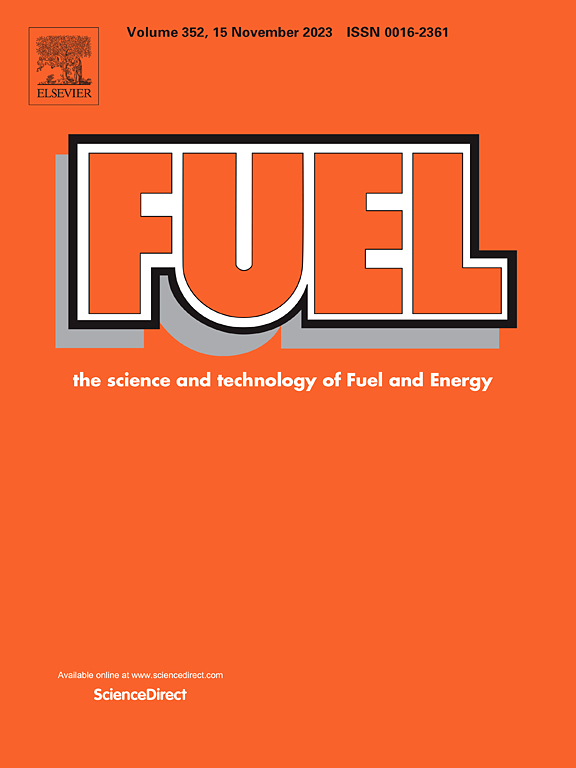Comparative DFT study on the reaction mechanism of dry reforming of methane over Ni (111), Ni@Co (111) and Co (111) surface
IF 6.7
1区 工程技术
Q2 ENERGY & FUELS
引用次数: 0
Abstract
Ni-Co bimetal is a considerably promising catalyst to apply in DRM process, and the unique Ni@Co core–shell structure maybe improve the activity and stability, but the reaction pathways and underlying mechanism on Ni@Co surface at the micro level need to be further uncovered. In current work, the adsorption of intermediates and the elementary reactions were systematically investigated based on Density Functional Theory calculations, and reason for Ni@Co core–shell structure enhancing the catalytic performance was obtained by comparing the related energies on Ni (111), Ni@Co (111) and Co (111) surface. Results suggested that CH4 dehydrogenation is the rate-determining step for CH4 activation, and the activation energy barrier is 1.43 eV on Ni@Co (111) surface, higher than 1.27 eV on Ni (111) and 1.31 eV on Co (111) surface. Compared with pure Ni and Co catalyst, Ni@Co core–shell catalyst could reduce the carbon formation by inhibiting the CH4 dissociation into C. Moreover, CO2 direct dissociation is dominating path for CO2 activation process. The activation energy barrier is 0.56 eV on Ni (111) surface, and it is further decreased to 0.36 eV on Co (111) surface and 0.22 eV on Ni@Co (111) surface. Ni@Co core–shell structure could promote the CO2 activation to produce more oxygen species to the oxidize CH and C. Moreover, Ni@Co core–shell structure is also contribute to the elimination of carbon deposited by promote C oxidation and hydrogenation. Furthermore, Ni@Co core–shell structure could also reduce the activation energy barrier of CO and H2 formation, and increase the activation energy barrier of H2O formation, which could suppress the generation of by-products and improve the selectivity of target products.
Ni(111)、Ni@Co(111)和Co(111)表面甲烷干重整反应机理的DFT对比研究
镍钴双金属是一种很有前景应用于DRM工艺的催化剂,其独特的Ni@Co核壳结构可能会提高活性和稳定性,但在微观层面上,其在Ni@Co表面的反应途径和作用机理还有待进一步研究。本研究基于密度泛函理论计算系统地研究了中间体的吸附和基本反应,并通过比较Ni(111)、Ni@Co(111)和Co(111)表面的相关能得到Ni@Co核壳结构增强催化性能的原因。结果表明,CH4脱氢是CH4活化的决定步骤,在Ni@Co(111)表面的活化能势垒为1.43 eV,高于Ni(111)表面的1.27 eV和Co(111)表面的1.31 eV。与纯Ni和Co催化剂相比,Ni@Co核壳催化剂可以通过抑制CH4解离成c来减少碳的生成,并且CO2的直接解离是CO2活化过程的主要途径。Ni(111)表面的活化能垒为0.56 eV, Co(111)表面的活化能垒为0.36 eV, Ni@Co(111)表面的活化能垒为0.22 eV。Ni@Co核壳结构可以促进CO2活化产生更多的氧来氧化CH和C,并且Ni@Co核壳结构也有助于通过促进C的氧化和氢化来消除沉积的碳。此外,Ni@Co核壳结构还可以降低CO和H2生成的活化能垒,提高H2O生成的活化能垒,从而抑制副产物的生成,提高目标产物的选择性。
本文章由计算机程序翻译,如有差异,请以英文原文为准。
求助全文
约1分钟内获得全文
求助全文
来源期刊

Fuel
工程技术-工程:化工
CiteScore
12.80
自引率
20.30%
发文量
3506
审稿时长
64 days
期刊介绍:
The exploration of energy sources remains a critical matter of study. For the past nine decades, fuel has consistently held the forefront in primary research efforts within the field of energy science. This area of investigation encompasses a wide range of subjects, with a particular emphasis on emerging concerns like environmental factors and pollution.
 求助内容:
求助内容: 应助结果提醒方式:
应助结果提醒方式:


